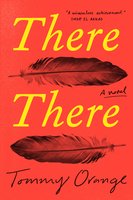The John Leonard Prize, our annual award based on member nominations and chosen by a panel of member volunteers, is awarded for the best first book in any genre. In advance of the announcement, we're inviting members to contribute appreciations of titles under consideration. (If you're interested in doing so, please email nbcccritics@gmail.com with the subject line Leonard.) Below, Hamilton Cain writes on Tommy Orange's debut novel, “There There” (Knopf).
 The expatriate Gertrude Stein, whose writing emulated her close friend Picasso’s art, famously said of Oakland, California, her hometown, “There is no there there,” which has come down to us through the years as a kind of Cubist ars prosaica. One interpretation considers Stein’s declarative sentence a nostalgic elegy: The town she remembers – “there” – no longer exists, degraded by time and economic downturns. Another interpretation is more cynical, dismissive, a flick of the hand at Oakland’s lack of a soul–it ain’t there.
The expatriate Gertrude Stein, whose writing emulated her close friend Picasso’s art, famously said of Oakland, California, her hometown, “There is no there there,” which has come down to us through the years as a kind of Cubist ars prosaica. One interpretation considers Stein’s declarative sentence a nostalgic elegy: The town she remembers – “there” – no longer exists, degraded by time and economic downturns. Another interpretation is more cynical, dismissive, a flick of the hand at Oakland’s lack of a soul–it ain’t there.
Set in Oakland, There There, Tommy Orange’s assured, devastating debut, confronts faceted meanings of place as well as how and why past, present, and future converge. From James Welch to Louise Erdrich to Sherman Alexie, Native novelists have explored the alienation and agonies of the reservations, where extreme poverty and alcoholism link arms as if in a tribal dance. The experiences of urban Indians have remained largely under the radar.
There There goes there: Its Native characters are exposed to the same radioactive prejudices as on Alexie’s Spokane “rez,” but also stare down other threats. A member of the Cheyenne and Arapaho tribes, Orange roams among perspectives, fleshing out his characters, whose stories eventually braid together, and lending heft to history. He opens with a stirring prologue that impressionistically recounts notorious events in Manifest Destiny, from the Pilgrims’ possible poisoning of Indians at an early Thanksgiving feast t0 the Sand Creek massacre of 1864: “The Indian head in the jar, the Indian head on a pike were like flags flown, to be seen, cast broadly.” He then shifts into his story proper, which turns on a present-day lead-up to the annual Oakland powwow, building spine-knotting suspense. This will not end well.
In There There we meet an indelible cast that includes Tony Loneman, afflicted with the “Drome” (i.e., fetal alcohol syndrome); Octavio Gomez, hatching out a murderous scheme; two middle-aged sisters, Opal Bear Shield and Jacquie Red Feather, reckoning with secrets from their past; and Opal’s adopted grandson, Orvil, whose immersion among Indians at the powwow highlights Orange’s lyrical gifts as well as his gimlet-eyed exploration of the divided Indian psyche: “There are hundreds of dancers in front of him. Behind him. To his left and right. He’s surrounded by the variegation of color and pattern specific to Indianness . . . geometrically sequenced sequin shapes on shiny and leathered fabrics, the quill, bead, ribbon, plume, feathers from magpies . . . He is an old station wagon at a car show. He is a fraud.”
A culture at war with itself, the atrocious persecutions of Native peoples, a prose so finely cut it slices the soul like a razor — these are the elements that Orange seams together. His characters lodge in our minds and hearts, and never leave. They try and fail to love. They lick their wounds. They hold down jobs. They get drunk. In spite of all the pain Oakland is their own reservation; they’re forging their fates there, lives blooming and moldering among cracks in the city’s pavement. Brilliant and beautifully crafted, There There heralds an auspicious literary career.

